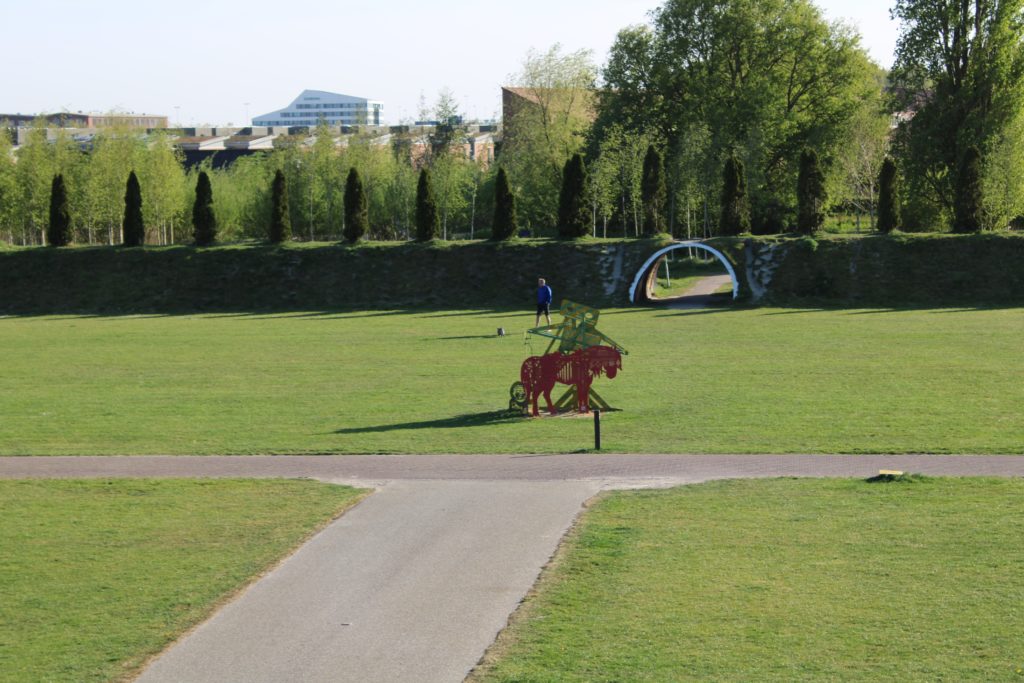When we think of the Netherlands, one of the main characteristics we think of bikes. Bikes are pretty much everywhere in the country. They are used by the dutch and the internationals, old and young, city or country. If you move here, a bike is one of your first purchases. Kids use them since they are small, sometimes as small as needing a flag to been visible by cars. Thus, it makes sense that cycling is combined with everything, including historical tourism.
The Netherlands, like almost every other country in Europe, has a Roman past. In particular, the south part of the country formed the north-west border of the Germania province. This border, or limes, as the Romans would call it, followed the line of the Rhine river, using it as a natural defence against the peoples in the North. The roman limes were not only in the Netherlands, but it also started in the west in the UK with the Hadrian’s Wall, continued through the European continent to the east to Turkey and Syria to keep going in Africa until the west in the Atlantic Ocean.

Tabula Peutingeriana / Image: Aida Loy 
Tabula Peutingeriana with marks on the west and east limits of the Dutch limes / Image: Aida Loy
Some parts of the Roman limes are included in the UNESCO heritage site, like Hadrian’s wall. The border that crossed the Netherlands and part of Germany following the Rhine has been proposed and is waiting for the verdict in 2021.
As part of the UNESCO inclusion project, the Netherlands created a joined heritage project to manage all the limes sites and remains. As well as the creation of activities, the promoting of museums along with the limes, and one of the most interesting, a biking route along the Roman border.

The Romans arrived at the Netherlands around the 50BC with Julius Caesar and stayed until the 400AD with the arrival of northern tribes, the Franks, who took over the area. Of course, the assimilation of the roman for the tribes who were settled in the area wasn’t immediate. But during two centuries the relationship progressed until the total romanisation in the 2nd century. Due to its location, the Roman-Netherlands is populated with military camps mostly, sometimes accompanied by a town.

Again, as in many other towns in Europe, most of these towns and fortifications continued to be populated, and many of the Roman remains have been lost or stay under the newest constructions.

The cycling route (around 200km) starts in the roman Noviomagus currently Nijmegen in the east of the country. In this city as well as remains included in parks and all along the city, there is a Museum which host remains from the city’s past.


Ruins of a medieval building on the Roman town in Nijmegen / Photo: Aida Loy 
Medieval building Het Valkhof built on the Roman town in Nijmegen / Photo: Aida Loy
On its pass by Utrecht, several museums are showing the past of the town. Sadly, a lot of the remains in the city centre were lost in a fire in the middle ages.
In Alphen aan de Rijn, the museum became almost an amusement park, as history is recreated for everyone’s entertainment. Some interesting activities include a gladiator fight and a gladiator market on the purest roman way.

In the west, there are several sites, as it was an important area to protect. Some of the spaces are lost or not excavated. But, even those are marked in the landscape so visitors can still feel that they are following the limes. In the town of Leiden or the roman Lugdunum, the visitor can see the roman camp Matilo.
And they can find it for real. After the archaeological excavations of this military fort, the site managers decided to cover the excavation area similarly as the fort was built on Roman times. It has four gates, marking the two main streets.

South gate to Matilo / Photo: Aida Loy 
North gate to Matilo / Photo: Aida Loy
Each of the gates is protected with two vigilance towers that are connected to the others by a wall, in this case, reconstructed with vegetation to minimise the damage to the archaeological remains. On the outside of these walls there is a pit, that in Roman times was filled with spikes, but cover with grass nowadays.

Vigilance Tower at Matilo / Photo: Aida Loy 
View of the wall and pit from the gate tower / Photo: Aida Loy
All over the fort, there are metal outlines with information. For example, the information about the animals that could be found in a military camp is hosted in the outline of a horse.

Heritage management and cultural tourism are developing faster than ever. Along with the need for more ecological solutions for our daily life but our holidays and free time activities as well. So cycling while discovering archaeological sites and other cultural spaces is a good and inventive solution, mostly in a bike-accessible country like the Netherlands.
